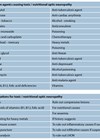Being the subject of litigation is stressful and upsetting. Having to look back over your previous decisions and justify the care you delivered in good faith can be difficult. Sadly, we all live with the sword of Damocles above us and even many years down the line, our errors can come back to haunt us. As an expert witness, it is sad to see clinicians being hauled over the coals for human errors that could happen to any of us but nonetheless still represent a breach of duty.
My Masters in Medical Law has given me an insight into the workings of the court and primarily my duty is to that court regardless of my sympathy with the Defendants or the Claimants. As part of my work, I have come across cases which recur time and time again. It is heartbreaking to see patients come to harm and clinicians accused of negligence due to errors which could be so easily avoided and yet trigger a cascade of events which result in detriment to the patient.

We have a duty to patients to protect them and moreover a general duty to prevent these errors occurring throughout the NHS, and sharing these cases with the readership will hopefully do that. The following are four case vignettes which all refer to negligence related to drug toxicity. I personally have dealt with four or more cases which represented a possibility of a breach in duty due to simple and avoidable errors.
Hydroxychloroquine (HCQ) toxicity
HCQ is a drug used in the treatment of rheumatological and dermatological disorders. Its big brother, chloroquine, used to be highly toxic, however despite its improved safety profile, retinal toxicity is a significant and potentially sight-threatening risk.
Case vignette
A 45-year-old woman was being treated with HCQ. She was taking a dosage of 400mg once daily and had been doing so for the previous seven years. She had a history of eating disorders and at presentation to the ophthalmology service her weight was 47kg.
She developed some colour vision disturbance and was referred in via her optometrist. No mention of HCQ was made in the referral and on attendance at the clinic she was not questioned on her medication despite a history of systemic lupus erythematous (SLE) being elicited. No abnormality was detected, visual acuities were 6/6 OU and she was discharged.
She represented three months later with vision of 6/36 OD and 6/60 OS. HCQ toxicity was diagnosed, and the drug immediately stopped. Visual acuities recovered to 6/18 OS and 6/24 OD but no better.
Discussion
Clearly there is the possibility of a breach in duty in not eliciting an appropriate drug history even though the patient had a history of a systemic disorder. Early toxicity can be missed, and the classical 'bull's eye' maculopathy is a late finding. A high index of suspicion should be harboured for toxicity in patients who have been on the drug for more than five years.
"It is heartbreaking to see patients come to harm and clinicians accused of negligence due to errors which could be so easily avoided and yet trigger a cascade of events which result in detriment to the patient"
Recent epidemiological studies indicate that retinal toxicity occurs in greater than 10% of patients who have taken HCQ for over 10 years, and 20-50% of patients taking HCQ for greater than 20 years [1].
However, for patients who are treated with HCQ below the guideline of 5.0mg / kg measured body weight, the incidence is less than 1% at five years and only 2% at 10 years [2].
Therefore, the threshold dose should be calculated using actual body weight rather than ideal body weight, and the maximum safe dose is 5.0mg / kg. For example, in this case the patient should have been on a maximum of 235mg of HCQ per day. Although prescribing the drug is without an ophthalmologist’s remit, it is entirely reasonable to question a sight-threatening, inappropriate dosing regimen in a patient who is objectively underweight.
The 2009 Royal College of Ophthalmologists Guidelines on HCQ screening advises referral to an ophthalmologist only if the patient has baseline visual impairment, eye disease confirmed by an optometrist or if the patient notices visual symptoms [3].
Some patients’ retinopathy progresses despite stopping treatment; involvement of the external limiting membrane on optical coherence tomography (OCT) carries negative prognostic value, suggestive of irreversible photoreceptor damage [4].
Message
If there is a suspicion of HCQ toxicity there should be consideration of stopping the drug and a formal ophthalmology evaluation should occur/be requested. Liaison with the prescribing doctor is vital to balance up the risk versus benefit profile of recommencing the drug if toxicity is not confirmed but suspected. Dosage should be correlated to weight of the patient.
Ethambutol toxicity
Tuberculosis (TB) that is caused by Mycobacterium is one of the most important systemic infections around the world. Ethambutol is a first-line medication that is used in TB therapies, however, it can cause blindness. Ethambutol-induced optic neuropathy (EON) is a well-known complication arising from the use of ethambutol, the severity of which is a dose-dependent manner.
Case vignette
A 45-year-old man was on ethambutol for respiratory TB. He presented to his optician with blurred vision and the optician queried ethambutol toxicity. He was referred onto the local eye casualty.
Visual acuities were 6/12 and 6/9 on presentation. Ocular examination was documented as being unremarkable. A follow-up appointment with refraction was arranged for two weeks. At next visit visual acuities were counting fingers (CF) and 6/60. The drug was stopped but visual acuity failed to recover.
Discussion
Clearly there was a possibility of a breach in duty in not stopping the ethambutol at the first presentation. If there is a suspicion of EON, the drug should be stopped and then the ocular status assessed and observed.
The overall incidence of EON in TB cases receiving ethambutol was about 1% that is correlated to the dosage [5].
The benefit of cessation of the medication in restoring vision is equivocal and there are several reports of permanent damage [6-8]. The clinical characteristics of EON include painless loss of central vision and cecocentral scotomas. There have been several studies regarding the incidence of EON in different countries, which is close to 1% [9,10].
The onset time of EON is unpredictable. The ocular symptoms develop from a few days to two years after the initiation of drug use [11]. Patients typically present with bilateral blurred vision and scotomas. Objective pathological findings may be absent and so a high index of suspicion should be maintained, and these symptoms taken seriously in patients on ethambutol.
Message
Consider EON. If it is on the differential diagnosis, it is safer to stop the drug and review the situation rather than continuing the drug which could cause permanent visual loss. Liaise with the team prescribing the ethambutol and consider the risk versus benefit profile of stopping the drug.
Intracameral cefuroxime
Since the results of the ESCRS study in 2007, postoperative endophthalmitis prophylaxis in cataract surgery has evolved toward intracameral cefuroxime as the standard of care [12-14]. And there have been reports of toxicity from cefuroxime and also the dilemma of whether intracameral cefuroxime should be used in patients with an allergy to penicillin.
As with any part of clinical practice we must be able to demonstrate that we did the best for the patient and ensure our practice is evidence based.
Case vignette
A 71-year-old gentleman underwent routine cataract surgery. The nurses in theatre drew up the incorrect dosage of cefuroxime which was injected into the anterior chamber. The patient developed corneal oedema and severe cystoid macular oedema, both of which failed to resolve.
Discussion
Several cases of early postoperative macular oedema have recently been reported after cefuroxime injection, most of them due to accidental cefuroxime overdose [15,16]. Cases of macular infarction [17,18] and toxic anterior segment syndrome [19] have also been reported.
Dosing errors will hopefully become less common with pre-prepared formulations such as Aprokam™ being available, however there are still units where the cefuroxime is drawn up in house. Care must be taken to ensure the correct dosage is used. Visual recovery tends to be the rule, however in the above case it did not occur. Causation was muddied as there was no direct proven link between the high dose cefuroxime and the visual loss, however in the presence of an obvious overdose of cefuroxime the possibility of a breach in duty was admitted.
It is ultimately the surgeon’s responsibility to ensure the drug they administer is correct and therefore surgeons should be actively involved in training and supervising the staff assisting them.
The Royal College of Ophthalmologists has recently issued guidance on what to do if a patient is allergic to penicillin [20]. This was issued in response to the survey of practice we undertook in Eye News, so your efforts in answering the surveys have borne fruit. The recommendations are:
- Take a thorough allergy history to determine whether the patient has a history of possible anaphylaxis.
- If there is a confirmed or suspicion of possible anaphylaxis to penicillin, intracameral moxifloxacin should be considered as an alternative.
- If there is no confirmed or suspicion of possible anaphylaxis to penicillin, based on the evidence we have considered, we recommend proceeding with intracameral cefuroxime.
- It is important to note that informed consent necessitates making patients aware of any and all material risks, as highlighted by the case of Montgomery vs Lanarkshire Health Board [21]. As such, a discussion must be had with the penicillin allergy patient in which their options and associated risks are discussed and clearly documented.
- Any adverse drug reactions must be reported to the Medicines and Healthcare products Regulatory Agency (MHRA) via the Yellow Card scheme, in addition to an in-house incident report as per local policy.
Not using intracameral cefuroxime
There have been criticisms of the ESRCS study, which recommended the use of intracameral cefuroxime including the high rate of endopthalmitis in the control group and whether to use topical antibiotics, however the evidence is sound and it is widely ‘accepted’ – it is now ‘standard practice’. When asked about whether you administered intracameral cefuroxime at the end of your cataract procedure many years ago the response was that 92.1% of you used it routinely. This still left 7.9% who did not use it which fits with the Bolam Test in that a responsible and reasonable body of medical opinion would support the practice. However, the test was modified by Bolitho to ensure that the practice was based on logic and the Court can, and will, find a possibility of a breach in duty if the practice does not stand up to scrutiny. This decision is often made by a learned judge and therefore it may be hard to argue the case for not using intracameral antibiotics at the end of the procedure when there is a strong evidence base and magnitude of medical opinion which supports it. I think we should all be using intracameral antibiotics at the end of our cataract procedures and if we do not, we should be prepared for criticism should an infection ensue.
Case vignette
A 67-year-old man has routine cataract surgery. Subconjunctival and topical antibiotics are administered at the end of the procedure. The patient goes on to develop endophthalmitis and loses the eye. The lawyer asserts that, on the balance of probabilities, had the surgeon used intracameral antibiotics at the end of the procedure the infection would not have occurred, and the vision would have been perfect. How would you argue against this based on the evidence?
Conclusion
Drug errors and toxicity are still occurring. We need to be vigilant for ocular toxicity and have a low threshold for questioning dosages for patients who are underweight. Trainees need to be taught to have a high index of suspicion for ocular toxicity when patients present with visual loss and they are on HCQ or ethambutol. Often stopping the drug and then confirming or refuting toxicity is the best course of action and could save sight.
References
1. Melles RB, Marmor MF. The risk of toxic retinopathy in patients on long-term hydroxychloroquine therapy. JAMA Ophthalmol 2014;132:1453-60.
2. Marmor MF, Kellner U, Lai TY, et al. Recommendations on screening for chloroquine and hydroxychloroquine retinopathy (2016 revision). Ophthalmology 2016;123:1386-94.
3. The Royal College of Ophthalmologists. Hydroxychloroquine and OcularToxicity Recommendations on Screening, The Royal College of Ophthalmologists, 2009.
https://www.rcophth.ac.uk/wp-content/uploads/
2014/12/2009-SCI-010-Ocular-Toxicity.pdf
[last accessed March 2017]
4. Yusuf IH, Sharma S, Luqmani R, Downes SM. Hydroxychloroquine retinopathy. Eye 2017;31(6):828-45.
5. Chen SC, Lin MC, Sheu SJ. Incidence and prognostic factor of ethambutol-related optic neuropathy: 10-year experience in southern Taiwan. Kaohsiung J Med Sci 2015;31(7):358-62.
6. Carr RE, Henkind P. Ocular manifestations of ethambutol, toxic amblyopia after administration of an experimental antituberculous drug. Arch Ophthalmol 1962;67:566-71.
7. Woung LC, Jou JR, Liaw SL. Visual function in recovered ethambutol optic neuropathy. J Ocul Pharmacol Ther 1995;11:411-9.
8. Tsai RK, Lee YH. Reversibility of ethambutol optic neuropathy. J Ocul Pharmacol Ther 1997;13:473-7.
9. Lim SA. Ethambutol-associated optic neuropathy. Ann Acad Med Singapore 2006;35(4):274-8.
10. Lee EJ, Kim SJ, Choung HK, et al. Incidence and clinical features of ethambutol-induced optic neuropathy in Korea. J Neuroophthalmol 2008;28(4):269-77.
11. Chatterjee VK, Buchanan DR, Friedmann AI, et al. Ocular toxicity following ethambutol in standard dosage. British J Dis Chest 1986;80(3):288-91.
12. Barry P, Seal DV, Gettinby G, et al. ESCRS study of prophylaxis of postoperative endophthalmitis after cataract surgery: preliminary report of principal results from a European multicenter study. J Cataract Refract Surg 2006;32(3):407-10.
13. Díez MR, De la Rosa G, Pascual R, et al. Prophylaxis of postoperative endophthalmitis with intracameral cefuroxime: a five years’ experience. Arch Soc Esp Oftalmol 2009;84(2):85-9.
14. Pleyer U, Geldsetzer K. Will intracameral cefuroxime become the new standard in endophthalmitis prevention? Klin Monatsbl Augenheilkd 2008;225(11):934-40.
15. Promelle V, Jany B, Drimbea A, et al. Tolerability of intracameral cefuroxime during cataract surgery in case of penicillin allergy. J Fr Ophtalmol 2015;38(4):283-7.
16. Wong DC, Waxman MD, Herrinton LJ, Shorstein NH. Transient macular edema after intracameral injection of a moderately elevated dose of cefuroxime during phacoemulsification surgery. JAMA Ophthalmol 2015;133(10):1194-7.
17. Çiftçi S, Çiftçi L, Dağ U. Hemorrhagic retinal infarction due to inadvertent overdose of cefuroxime in cases of complicated cataract surgery: retrospective case series. Am J Ophthalmol 2014;157(2):421-5.
18. Qureshi F, Clark D. Macular infarction after inadvertent intracameral cefuroxime. J Cataract Refract Surg 2011;37(6):1168-9.
19. Delyfer MN, Rougier MB, Leoni S, et al. Ocular toxicity after intracameral injection of very high doses of cefuroxime during cataract surgery. J Cataract Refract Surg 2011;37(2):271-8.
20. The Royal College of Ophthalmologists. Intraoperative Antimicrobial Prophylaxis in Elective Cataract Surgery Patients.
https://www.rcophth.ac.uk/resources-listing/
intraoperative-antimicrobial-prophylaxis-in
-elective-cataract-surgery-patients/
[last accessed June 2023].
21. Montgomery v Lanarkshire Health Board [2015] UKSC 11.
COMMENTS ARE WELCOME








